Communism
1/42
Earn XP
Description and Tags
See women & work + leisure lectures alongside this
Name | Mastery | Learn | Test | Matching | Spaced |
|---|
No study sessions yet.
43 Terms
TWE did communism question existing frameworks of gender?
what role did gender play in communist ideology & propaganda?
Did communism transform gender norms?
What do we mean by ‘communism?
Theory communism
Communism emerged as response to rapid industrialisation & urbanisation
econ. setup: working land → wage-labourers work. in factories
Communist thinkers v/critical power relationships had emerged in this soc. + social & econ. inequalities capitalism was created
Sugg. new way ordering soc. that would replace private prop. & proft-mak. wth public ownership as means prod.
Put WC (proleteriat) @ centre.
Practice communism would have been surpirisng for originators communist ideology
(early on: Bolshevik) 1 party dictatorships w/leader cult (glorified, sanctified → hierarchical way running country)
∵ req. dramatic restructing soc.?
when came to power, dramatically reorgan. econ., politics and soc. (since proposing revolutionary idea to shift property from private to state ownership → need to reeorganise alm. every aspect life)
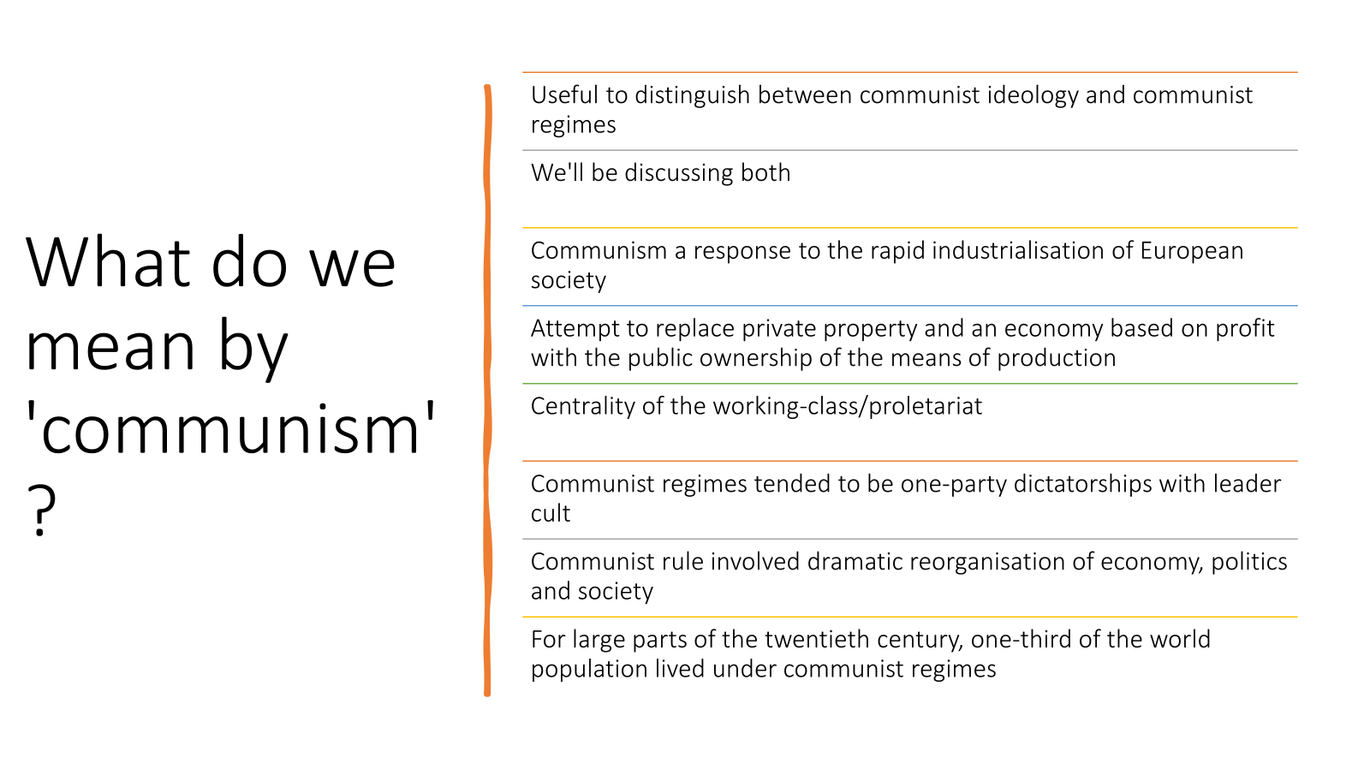
Where does gender figure in this?
It does ∵ communist ideology based ↺ class & class conflict, gender.
Class 👓n as most important identity, far ↑ than gender, race, ethnicity…
Gender alw. going to struggle to → central to communist ideology ∵ it alr. has its great idea
Whilst Marx really write ab. gender, Engels did give some thought to gender relations & 👪.
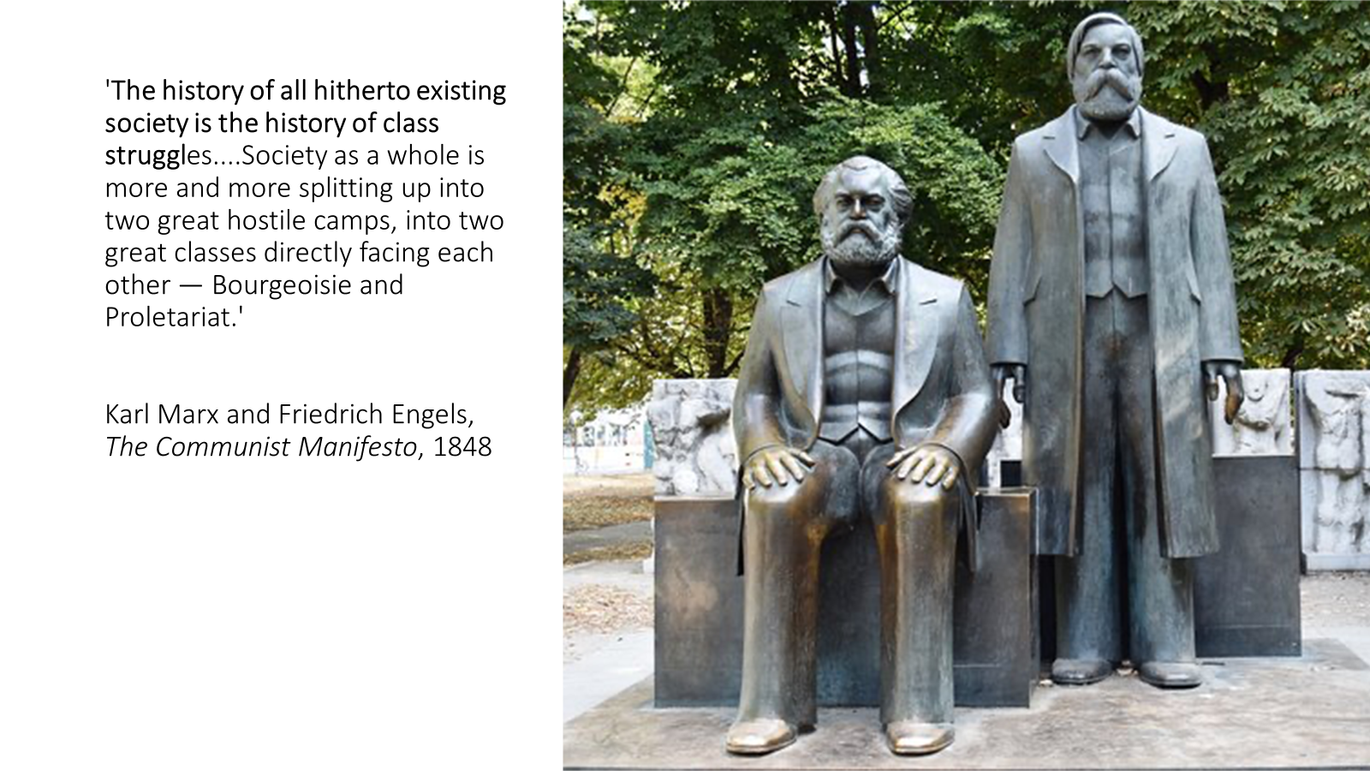
What did Engels say ab. 👪? ideolog women’s emancip.
How does capitalism restrict women?
What is the solution?
📚 The Origin of the 👪, Private Property & the 👾 (1884)
Written after 😵 Marx
How does capitalism restrict women?
Communist theory 👓 patriarchy as part & parcel class soc.
Theorised pre-agricultural societies martiarchal & pract. group marriages
Introd. priv. property necessitated monogamous ⚭ & gave 👨 supremacy. 👩 in bourgeious marriage ‘sells [her body] once & for all into slavery’ (power; merely piece 🤵’s property)
‘The supremacy of the 👨 in marriage is the simple consequence of his econ. supremacy,’
Once have private property, must think ab. inheritance
primogeniture (pass. down to son) = simple way keeping property tog.
Dominance 👨 in marriage went hand in hand w/their econ. dominance (2 things
can be sep.)
Solution…
👩 join workforce, → proleteriat and access their power.
Iif in domestic sphere & ecnomically active, would never have any power.
Communism would liberate 👩 via sociaisation lab. relations, includ. 👩’s partic. in waged lab → realise her productive pot.
envisioned socialising 👪
gen. entailed displac. 👪 work to socialised services (socialised econ. which woudl transfer most consumption, childcare & 🏠work ← 🏠 → public sector)
👩 must leave 🏠 for 🏭
But then who does the domestic work if that happens?
‘to emancipate 👩 & make her equal of the 👨 is & remains an
possibilityso long as the 👩 is shut out ← social productive lab. & restircted to priv. domestic lab. The emancip. of 👩 will only be poss. when 👩 can take part in production on a large, social scale, & domestic work no longer claims anyth. but ansignif.amount of her 🕑’
![<p><span data-name="books" data-type="emoji">📚</span> <em><mark data-color="yellow">The Origin of the </mark></em><mark data-color="yellow"><span data-name="family" data-type="emoji">👪</span></mark><em><mark data-color="yellow">, Private Property & the </mark></em><mark data-color="yellow"><span data-name="alien_monster" data-type="emoji">👾</span></mark><em> </em>(1884)</p><p>Written after <span data-name="dizzy_face" data-type="emoji">😵</span> Marx</p><h5 collapsed="false" seolevelmigrated="true">How does capitalism restrict women?</h5><p>Communist theory <span data-name="eyeglasses" data-type="emoji">👓</span> patriarchy as part & parcel class soc.</p><p>Theorised pre-agricultural societies martiarchal & pract. group marriages</p><p>Introd. priv. property necessitated monogamous ⚭ & gave <span data-name="man" data-type="emoji">👨</span> supremacy. <span data-name="woman" data-type="emoji">👩</span> in bourgeious marriage <span style="color: yellow">‘sells [her body] once & for all into slavery’</span> (power; merely piece <span data-name="person_in_tuxedo" data-type="emoji">🤵</span>’s property)</p><blockquote><p><em><span style="color: yellow">‘The supremacy of the </span></em><span data-name="man" data-type="emoji">👨</span><em><span style="color: yellow"> in marriage is the simple consequence of his econ. supremacy,’</span></em></p></blockquote><ul><li><p>Once have private property, must think ab. inheritance</p></li><li><p>primogeniture (pass. down to son) = simple way keeping property tog.</p></li><li><p>Dominance <span data-name="man" data-type="emoji">👨</span> in marriage went hand in hand w/their econ. dominance (2 things <s>can be sep.</s>)</p></li></ul><h5 collapsed="false" seolevelmigrated="true">Solution…</h5><p><span data-name="woman" data-type="emoji">👩</span> join workforce, → proleteriat and access their power.</p><p>Iif in domestic sphere & ecnomically <s>active</s>, would never have any power.</p><p><u>Communism would liberate </u><span data-name="woman" data-type="emoji">👩</span> via <mark data-color="blue">sociaisation lab. relations</mark>, includ. <span data-name="woman" data-type="emoji">👩</span>’s partic. in waged lab → realise her <span style="color: red">productive pot.</span></p><ul><li><p>envisioned socialising <span data-name="family" data-type="emoji">👪</span></p></li><li><p>gen. entailed displac. <span data-name="family" data-type="emoji">👪</span> work to socialised services (socialised econ. which woudl transfer most consumption, childcare & <span data-name="house" data-type="emoji">🏠</span>work ← <span data-name="house" data-type="emoji">🏠</span> → public sector)</p></li></ul><p><span data-name="woman" data-type="emoji">👩</span> <em>must leave </em><span data-name="house" data-type="emoji">🏠</span><em> for </em><span data-name="factory" data-type="emoji">🏭</span></p><p><em><span style="color: red">But then who does the domestic work if that happens?</span></em></p><blockquote><p><em><span style="color: yellow">‘to emancipate <span data-name="woman" data-type="emoji">👩</span> & make her equal of the <span data-name="man" data-type="emoji">👨</span> is & remains an </span><s><span style="color: yellow">possibility</span></s><span style="color: yellow"> so long as the <span data-name="woman" data-type="emoji">👩</span> is shut out ← social productive lab. & restircted to priv. domestic lab. The emancip. of <span data-name="woman" data-type="emoji">👩</span> will only be poss. when <span data-name="woman" data-type="emoji">👩</span> can take part in production on a large, social scale, & domestic work no longer claims anyth. but an </span><s><span style="color: yellow">signif.</span></s><span style="color: yellow"> amount of her <span data-name="clock2" data-type="emoji">🕑</span>’</span></em></p></blockquote>](https://knowt-user-attachments.s3.amazonaws.com/aea10452-04be-4844-a394-4a78a9a49222.png)
writing communist manifesto → creation communist regimes Europe after WWI
short period time, intense series events & huge gathering momentum on part communist movem.
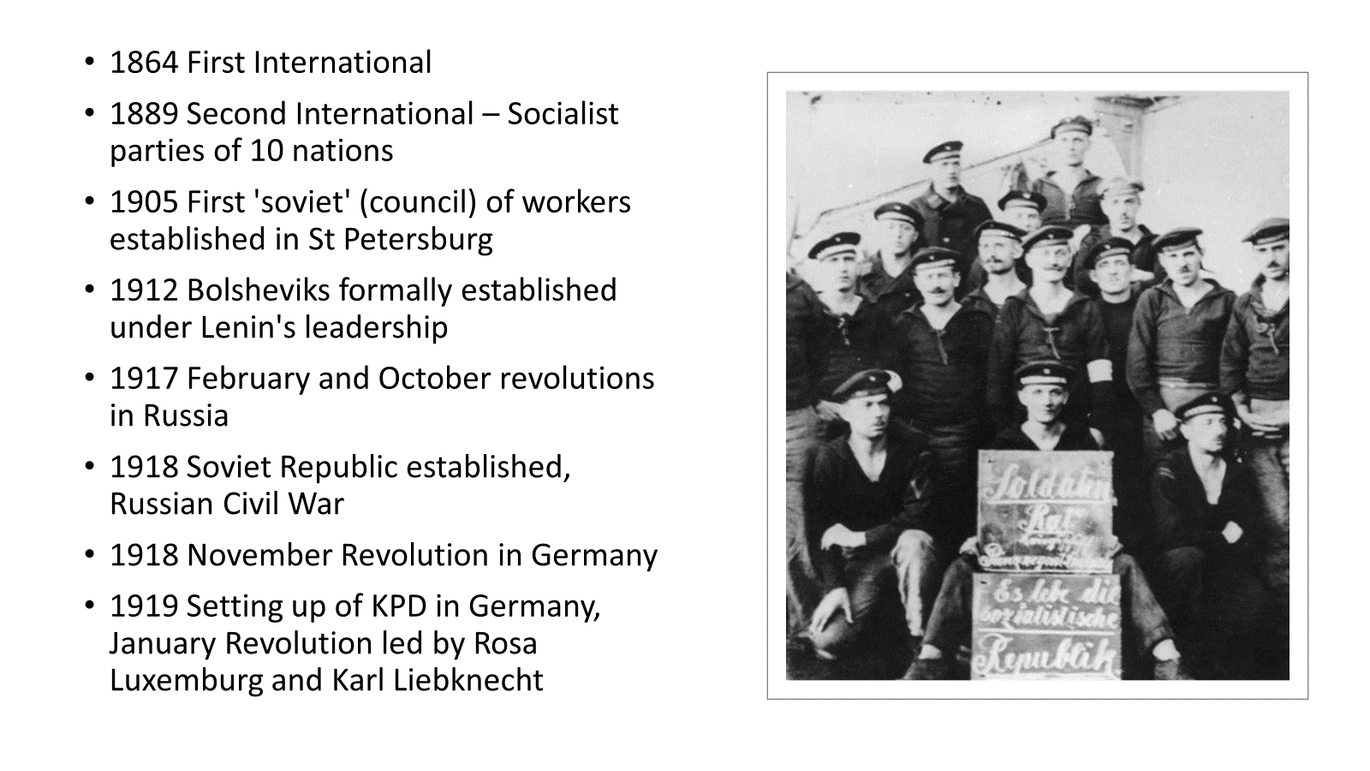
Communism attracts some well-known female leaders…
Unusual for their time, intellectual, experimental in their private lives (relationships)
1 of them = advocate for free love & end bourgeoise marriage
radicals
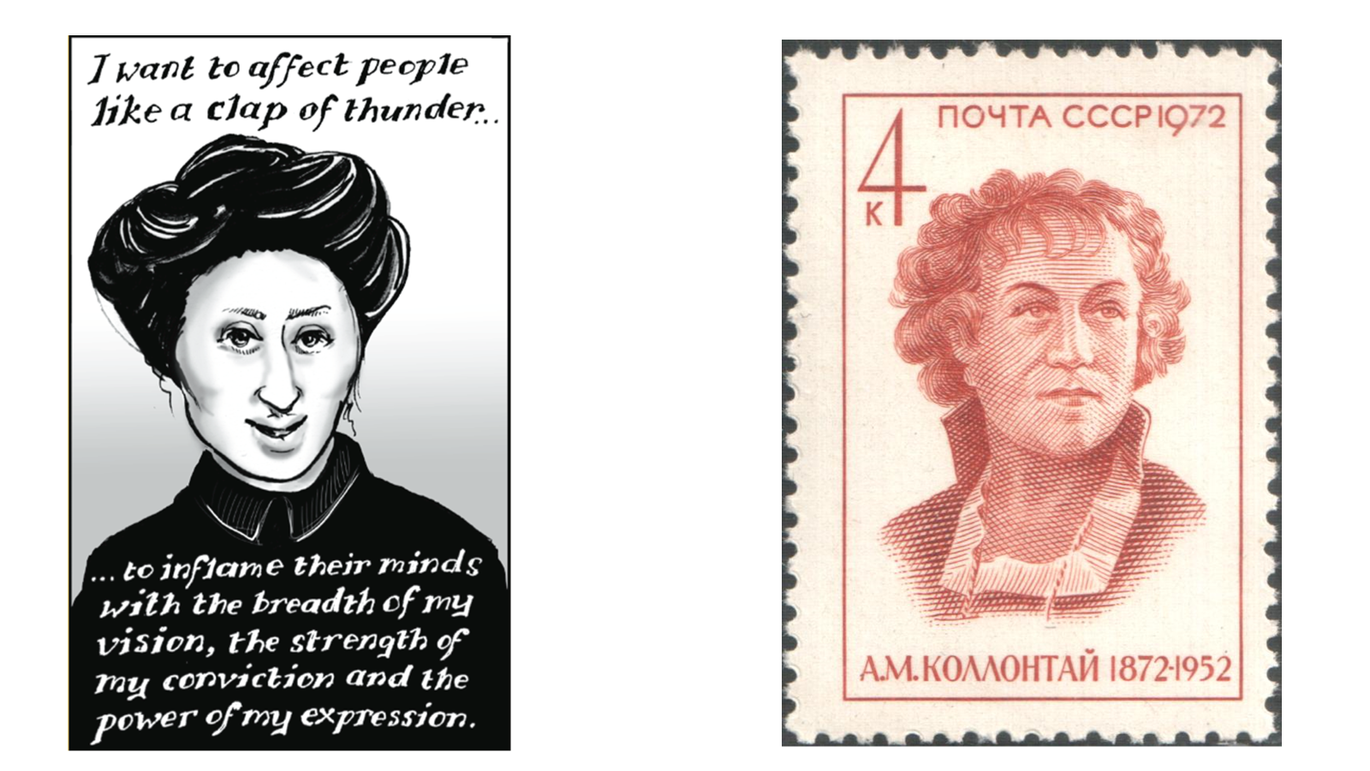
Under communism, did women achieve equality w/men?
historiography
(1950s-70s) Communism had succ. answered ‘woman question.
Communist state legally guaranteed women equal rights, opened public institutions to women & encourag. their partic. as citizens, workers & students; & implemented social policies benefitted women as mothers, married/ single.
(1980s-) Failed to realise gender equality.
downgrading communist achievements
(1980s) Rapid econ. decline & poltiical collapse colouored pop. & scholarly opinion ab. communism.
(by then) Western women attained/ surpassed advances communist sisters → prog. less enticing (looked less impressive)
New interpretive perspective 2nd wave feminism revised older feminist understand. women’s oppression → decried assumption women’s lib. = enter. public life as waged workers.
New feminism focused on gender relations in the private sphere, including sexuality, housework, and childrearing. It decried cultural norms regarding the ‘nature’ and roles of both men and women
Open. archives former communist 👾s prov. wealth tapped, crediting sources.
Reams of documents from state and party archives exposed the often poor quality behind impressive-looking percentages, the popular complaints and actions that prodded state decisions, and the fraught social processes behind positive outcomes.
early USSR introd. equalising laws
Marxist critique fam. → topic political debate.
(Alexandra Kollontai) 👪 would soon 'wither away'.
Does initially feel like things chang. for women…
Big changes in what is a con. soc.
Guaranteed legal equality
1918 Fam. Code gave children born outside marriage equal legal rights, & secularised marriage. Husbands could take wife’s name. Elimin. 🤵s’ privileges in division property & fam. dec.-mak. + legalised divorce. - Joint-spoudal dec.-mak. ab. children
- Wife’s right to take job against husband’s wishes
1920
abortion legalised
Ambitious plans for communal childcare & housekeeping (radicals called for 'communalisation' 🏠 hold). Dev. schemes for communal upbringing 10,000s 🧒 orphaned by rev. upheaval & civil war.
👩 party activists, jurists & social planners proposed 'free union' replace legal ⚭.
1920s USSR
Party authorities come to distrust feminist tendencies Women's Bureau (Zhenotdel) under Kollontai's leadership.
Emphas. ideology women's emancipation through public engagement & discouraged free-spirited argument ab. private life.
Women urged to partake w/men in communist activities for youth & workers
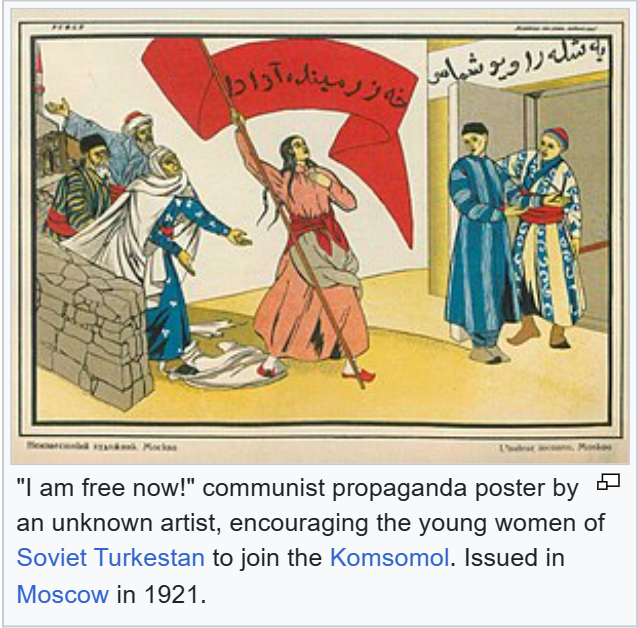
Women seen as agents of change (seen in 2nd photo), will driving things forw.
woman standing up to trad. & relig. values, claiming her lib. holding the red flag of communism
1 of the main ways they will do this is by joining the workforce… →
importance women to industrial transform.
Soviet econ. based on rapid transition to industrial econ. & collectivisation agriculture.
Achieve this via readily-avail., affordable lab. (little funding)
Had to mobilise women into workforce.
Getting them aw. ← husbands,
equalityfam. relationships & mak. them fully-fledged members proleteriat.After all, this was a state of the proleteriat.
Done via lots propagada show. women being strong, determined.
Ukrainians and Russians have common call ! No master over worker!
Work seen as means of emancip. for women - membership proletariat.
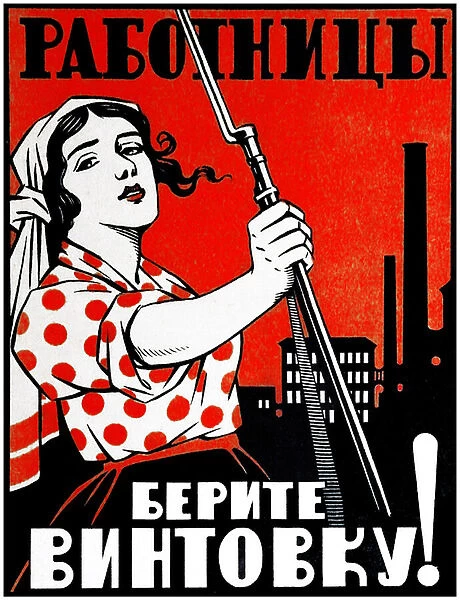
What happened to men & male roles under communism?
valorisation masculine
cultural discourse patriarchal
Early SU iconography & lang. constructed ‘new socialist person’ as ♂
Hyper-masculine idea
men strong, contrib. to agriculture, econ., brave soldiers, v/young, vigorous & muscular
thick neck, big hands…
Propaganda often played w/ideas masculinity & virility (2nd photo)…
proleteriat = young, strong, virile
bourgoiese = overweight, red in the face, ageing & unhealthy
common motif
But this is the ideology rather than reality… how do we understand how men reacted to this?
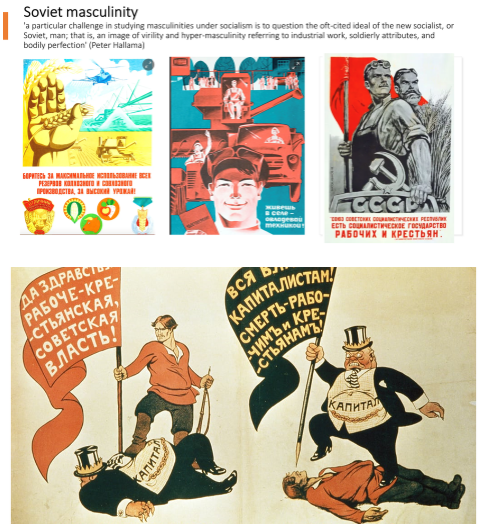
(Harsch, Donna) → demonisation feminine
Propaganda presented public life & activities (assoc. w/men) as superior to domestic life & home (assoc. w/women) – privileging public engagem.
Members Hungary’s politburu: women’s reproductive responsibilities held them back ß intense political activity expected ideal communist.
Poster-art placed muscular ♂ worker in centre, w/👩 in supporting roles.
Only 🖼ry directed @ ♀ audiences made 👩 main subject.
After utopian revolutionary period, many of these policies reversed 1930s…
Stalin’s ‘Great Retreat’ in 👪 policy
aim
Overcome unwanted social trends whilst ↑ no. 👩 in workforce.
declining birth rate
👩 changed but soc.
change w/themShared housekeeping, childcare… → 👩 had to balance their domestic responsibilities w/their lab. working in countryside
∴ many 👩 decided to limit 👪 size, tak. advantage avail. abortion in order to have ↓ 🧒
↑ in births to wed 👩
↑ing divorce rate
↑ rate juvenile crime/ rulin.
combined w/failure to est. communal domestic services…
Undermined by lack money, inadequate orphanages & fear kids running wild in streets.
→ turn tow. more pro-natalist politics
Worried Stalin: keeping pop. high important to succ. USSR (econ. plans, as mentioned earleir)
Abortion → more diffic. to access
Pro-natalist policies encourage larger family sizes
Pro motherhood propaganga - women’s trad. role, glorificatin & joys motherhood that could easily have been used in more con., fascist soc.
Stalin’s ‘Great Retreat’ in 👪 policy
gist 1936 legislation
this involved
benefits _ other good stuff
Revised 👪 law & social policy policy in 👪-friendly direction…
To emphas. foundational signif. ⚭ & 👪 to socialist soc. & raising 🧒, principle equality.
This involved…
Official rhetoric emphas. 👩's domestic (espec. reproductive) responsibilities in ☢ 👪.
1936 👪 code:
Registered ⚭
Tighter divorce regulations
Severe penalties for 👨 who reneged on 🧒 supp.
Recriminalised abortion
benefits
(Wendy Goldman) Supp. by many women
1926 code had recognized cohabitation as equal to registered ⚭. Divorce shot up in the cities, fathers
pay 🧒 supp., & 🤱s 👩 w/o resources
Soviet discourse still chall. ingrained sexist beliefs (e.g. notion 👩 lacked technical & military abilities).
🏫s encouraged 👧s to study maths & engineering; after-🏫 programmes trained them to shoot.
USSR WWII
CW
WWII
(WWII) Red Army deployed 10,000S female volunteers as radio operators, field medical personnel, snipers & fighter pilots.
1 mil. women part Red Army
Unique to USSR
Wome not recruited on this scale anywhere else
CW
Sim. proc. transform. in these Eastern European regimes…
(late 1950s) ↑ trad. – insist 👩 could work in ‘♂’ occupations
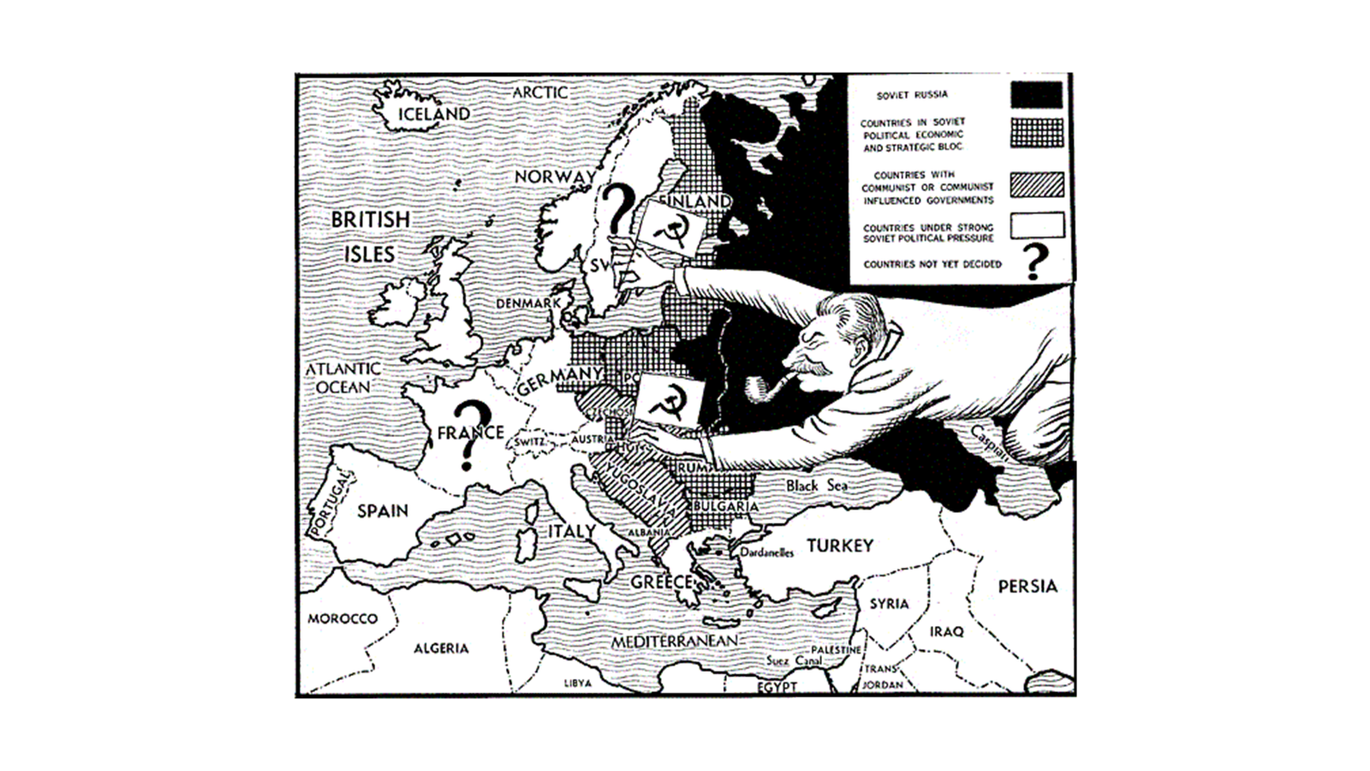
(Donna Harsch) women educ. USSR
Even though urban 👩 excelled educ., reach top tier.
Under-represented in physical sciences & technical fields.
Failed poor rural 👩.
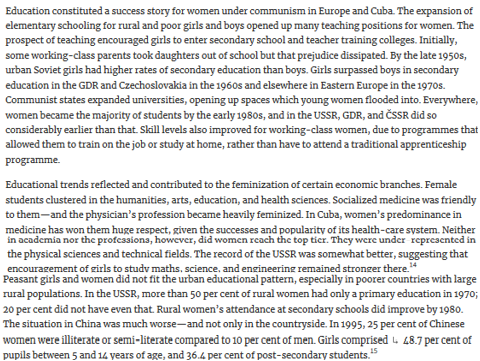
female employm. in Eastern European economies
gen. pattern
issues
gen. ↑ ♀ employm.
Brought 👩 every social status (⚭ & single, 🤱s & not, rural & urban, skilled & skilled) into waged lab.
(USSR) 1st 5-Yr Plan introd. 👩 workers into every branch industry.
(initially) Early phase industrialisation → prog. tow. breaking barriers to 👩’s employm. in ‘♂’ industries.
Seen below…
activity = paid employm.
(by 1985) Marked diff. bet. S.European countries (still low rate female employm.), W.Europe (56%), Scandinavian (71%) & Socialist countries (high)
impact socialist regimes
Hungary: 29% → 84.7%
start off at diff. points → end up same point
these are ILO statistics (internat. organ. whose role to organ. data)
collected locally → variations
by end period, socialist countries more aligned in how they collect data
BUT…
→ purpose industrialisation communist econ. - equality (?) merely means to an end, rather than end in itself → respected
Perhaps this is why failed de-gender workforce – contrib. to gender segmentation.
👩 predominantly → ‘💡 industry’ (skilled/ semi-skilled jobs)/ service occupations) → paid less.
(late 1950s) ↑ trad. –
insist👩could work in ‘♂’ occupations(E. Europe, USSR & Cuba) 👩 over-repres. in public health & social welfare, educ., govt administration, credit & insurance, retail trade & sales, restaurants & catering (easier to be promoted though 👨 dominated top managem.)
Gender equality failed in occupational distrib., skills, promotion, compensation.
∵ pop. resistance, inconsistent offic. commitment, women’s lack stills @ start point, path dependency & growth service sector.
Shared gender pay gap typical capitalist econ.
∵ kind occupations they filled; lower skill levels; biased job assignements; drag domestic duties on time & energy.
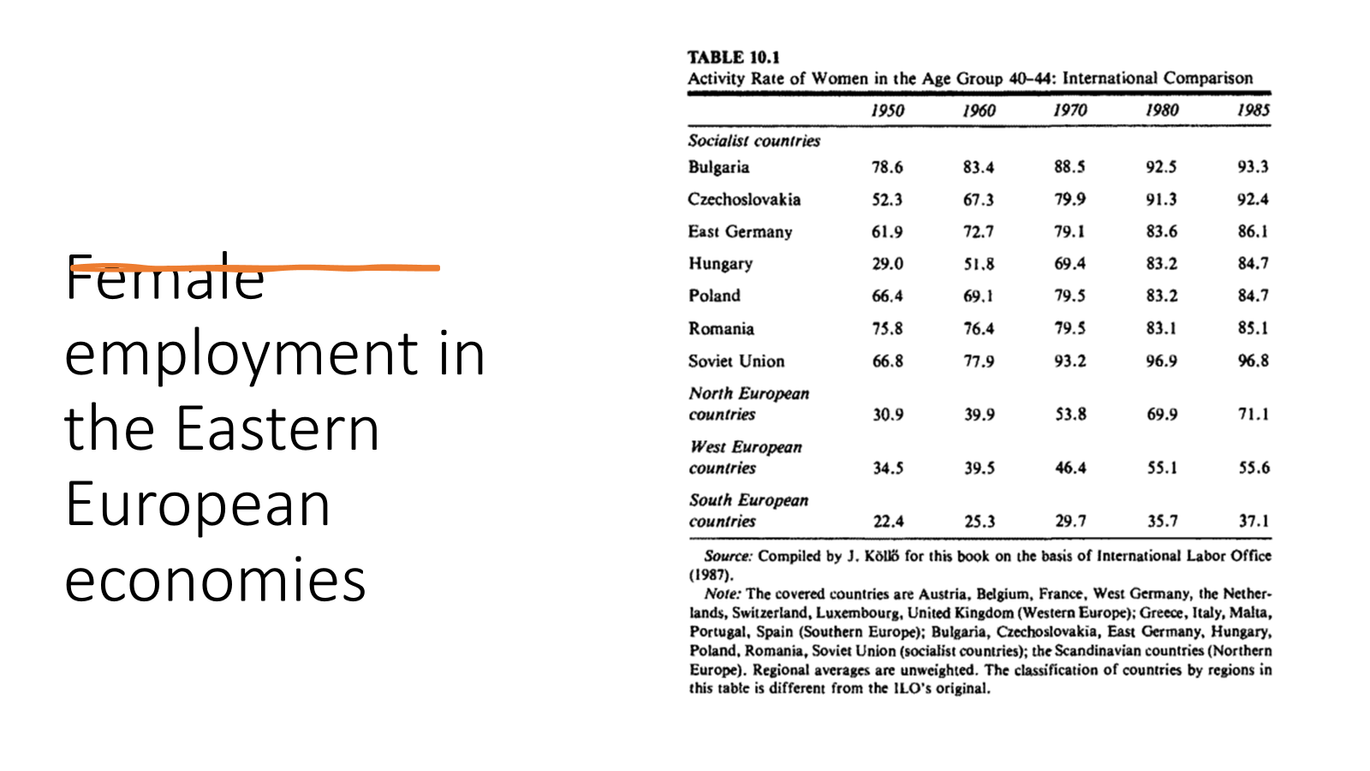
How did this manifest itself in poster art?
Women still highlighted & put in centre images but visual culture women’s work changed (link to seminar/ vocab. women’s work changed)
focus women being indep., in workplace (engineer/ surveyor, studying (textbook in front)
ambitious, prof., modern (mov. w/the times, keeping up w/trends)
these posters to celeb. internat. women’s day, to celeb. achievements women
🖼 accurately depicted (w/o chall.) feminisation retail sales & male composition others (e.g. construction).
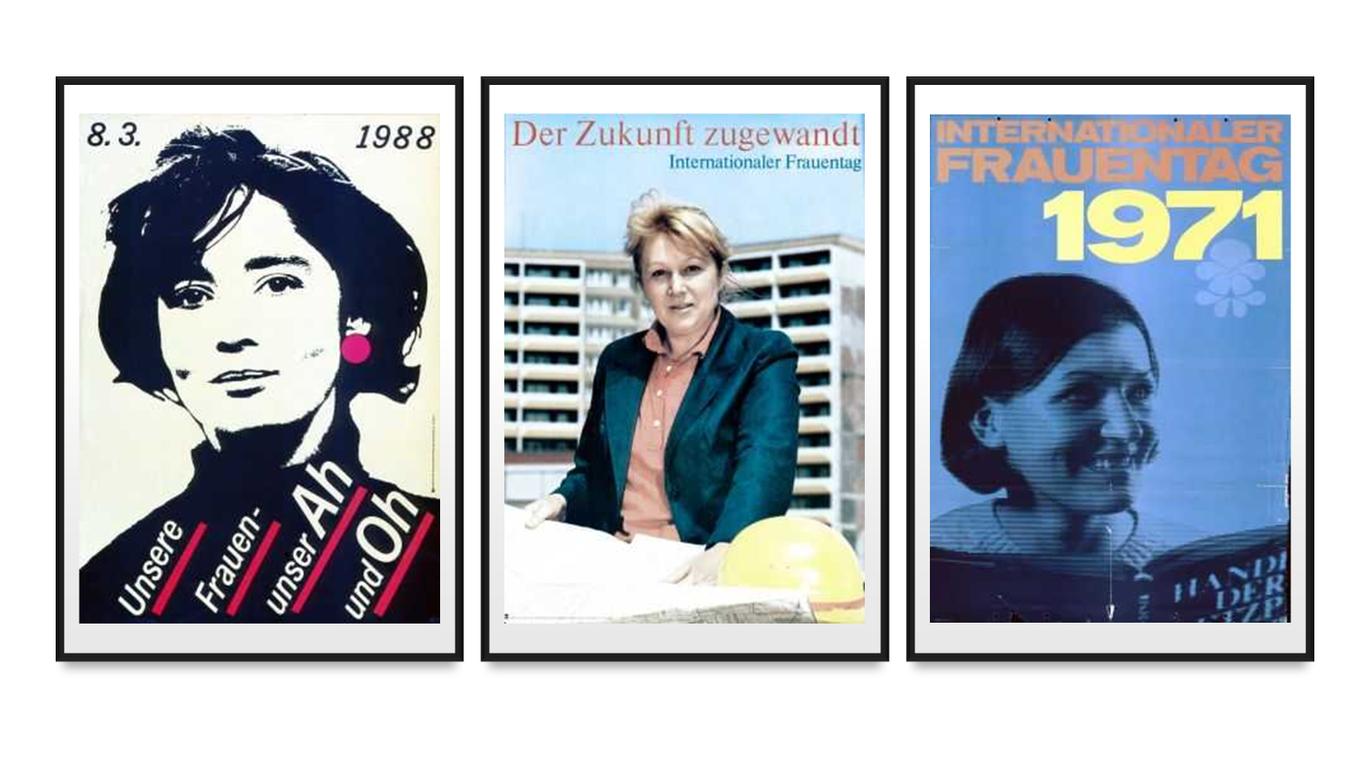
What problems did this cause for E.Europe & SU communist 👾s?
other causes this issue
How does this tie into conflict communism?
what action was taken
spotty record
(1960s) E.Europe & SU communist officials’ institutionalisation 🧒care
(1960s) E.Europe & SU communist officials’ institutionalisation 🧒care
officials displeased w/ ↑ divorce rates → ↓ birth rate → expansion natalist 📏s (institutionalised 🧒care).
Other causes
Urbanisation
↑ing levels ♀ educ.
Avail. birth control
👩’s workforce partic.
👾 hav. to mobilise lab. young 🤱s when waged lab. single 👩 & 🤱 w/older 🧒 dried up
How does this tie into conflict communism?
How to get women engaged in workforce, public life & politics whilst balance it w/their responsibilities as parents & housekeepers.
Needed women to work for wages & needed more children
Needed women to gain skils & need. children to be well-prepped for school & employm.
What does Gail Lapidus call E.Europe strategy for overcoming this conflict?
‘Straddle strategy’
Aimed to make it easier for women to combine reprod. & prod. by easing double burden + enhance quality life in ways would allow women to à more productive workers, whilst simult. meet. Higher standard child-rearing
What action was taken to overcome this conflict communism?
(1960s) How succ. was institutionisation 🧒care?
Why was this?
China
Moreover, due to thorough agricultural collectivization, domestic duties that used to be performed within the family units also required collectivization and the subsequent establishment of service centers for these duties. Newly established institutions such as cafeterias, kindergartens, and nurseries mushroomed and were mostly staffed by women. According to one source, “there were estimates that 4,980,000 nurseries and kindergartens and more than 3,600,000 dining-halls were set up in rural areas by 1959” (Stacey 1983: 214).
Spotty record
(1960) Only 13% 🧒 under 7 yrs old spent day in nursery/ kindergarten.
(by 1975) 37%, but remained m/↓ in countryside
Low quantity & low quality → 👩 cobbled tog. 🧒care, often depend. on their own 🧒s as caretakers, & complained continually to officials ab. lack day-care ‘slots’ for their 🧒.
Why was this?
Quandry expanding day care whilst tout. advantages fam. care
Dramatic expansion 🧒care limited by…
ideology
Psychologists & pop. opinion convinced policy makers maternal care better for y/children.
(Czechoslavkia) 16%
(Hungary, Poland & Romania) single-digit coverage
Not part ‘straddle strategy’ here.
check photo
lack funds
East Germany had to borrow ← West Germany
(by 1980s) Every Eastern European 👾 (but USSR) spent ↑ 20% GDP on social programmes & subsidies.
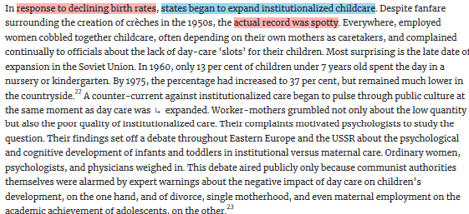
What action was taken to overcome this conflict communism?
pronatalist 📏s:
recriminalise abortionsbut but mixed record mak. contraception avail.
influence women on policy-mak. (last FC)
abortion
Despite interest in ↑ birth rate, only 1 communist 👾 (re)criminal. abortion-Romania - 1966.
(1955) USSR's (re)legalis. abortion.
(1971) GDR liegalised under internal pressure ← gynaecologists, 👩 activists & pregnant 👩, & eager to prove = better friend 👩 than was W. Germany.
(1979) Cuba legalised abortion
∵ high no. legal abortions + other 👾 wanted to implement Romania's invasive surveillance of 👩n's reprod. lives.
contraception
W/exception Romania, communist 👾s legally restrict contraception.
(1950s)
Spermicides & cervical caps v/hard to come by.
Condoms ↑ accessible but
abundant/good quality.
GDR 11st first countries to prod. BC 💊 'anti-baby pill'.
(1971 →) Its health system prov. 💊 for free.
In contrast,
avail. USSRas late as 1978.Major method BC abortion, though couples alsos reported us. condoms.
China stands out as a non-
natalist communist state that promoted 'family planning' from the 1970s on. Urban couples complied with
its two-child, then one-child, policy. Rural couples often did not. Selective abortion became widespread and
families under-reported female births. By the 1990s, 83 per cent of couples used contraception (mainly the
intrauterine device and female sterilization).26
put this in china section
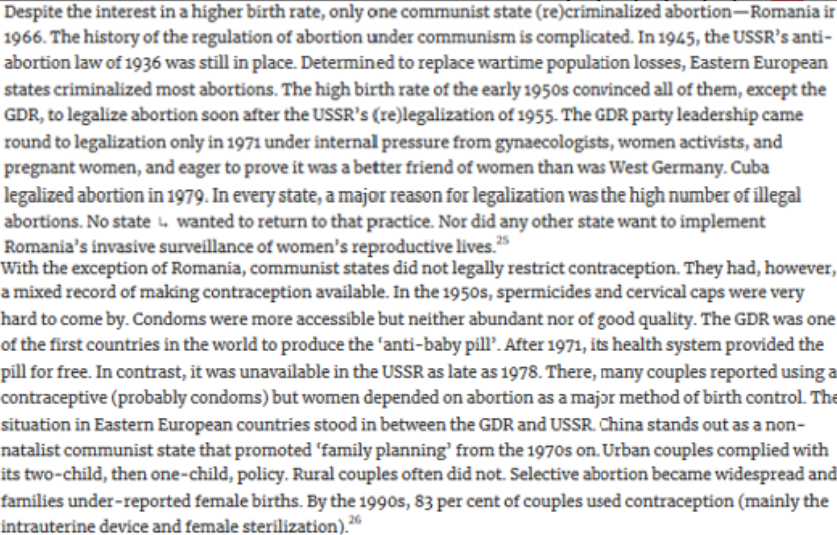
What action was taken to overcome this conflict communism?
consumer revol.
(1960s) 👩 helped by communism’s version consumer revol.
Officials recogn. as way to ↓ 👩’s double burden
(E. Europe) Every econ. ↑ prod. consumer durables, includ. fridges, wash. machines, vacuum cleaners & TVs
(1970s) USSR & Cuba followed suit
Helped 👩 combine employm., 🧒-rear. & 🏠hold lab.
Poor initiation Western blueprint also
solve 👩’s double burdenPlagued by shortages & bottlenecks
(early 1980s) Econ. difficulties hit every communist econ. → shortages even basic goods reappeared.
Mounting consumer
satisfactionplayed major role in ↑ly vocal popular protest → (1989-90) fall communism
What action was taken to overcome this conflict communism?
posters
1970s
motherhood @ centre other Internat. Women’s Day posters
What emphasis did this reflect?
How does this tie into conflict communism?
Continued emhasis fam.
Highlighted women’s domestic roles & signif. 👪 for rais. (↑)🧒.
Despite conflict…
Nevertheless, little attempt to get 👨 to step up & do domestic work → giving women double burden, working outside home & in home
these posters are attempt to recogn. women’s role as mothers but also to beautify it & make women feel motherhood is v/worthwhile
👪’s happin. dependent on mother’s & vice-versa
theme internat. cooper.
What action was taken to overcome this conflict communism?
posters
Where did men fit into this?
1980s
👩 thriv., living their best lives → how do 👨 fit into this when
longer head 🏠hold/ top hierarchy in workplace?
Cartoon 🎭s man being bullied by his wife → 👨 los. their role in 👪
Grad. → more attentive to 👩’s double burden. Put pressure on 👨 to help their 👰♀s in 🏠hold.
Cultural repres. both men & women → less idealised & ↑ realistic.
→ Publicists did encourage fathers to develop closer relations w/their 🧒s.
Attempt (by end communism) to create new role for 👨, to think ab. their role as fathers & how they might get satisfaction ← parenthood
Portrayed each gender’s array everyday roles, yet still emphas. women’s maternal role ↑ than they did men’s paternal responsibillities - work in prog.
🖼 accurately depicted (w/o chall.) feminisation retail sales & male composition others (e.g. construction).
poster East Germany shows bond bet. father & child giv. father satisfaction)
but still work in prog.
not transform. gender relations that had been promised
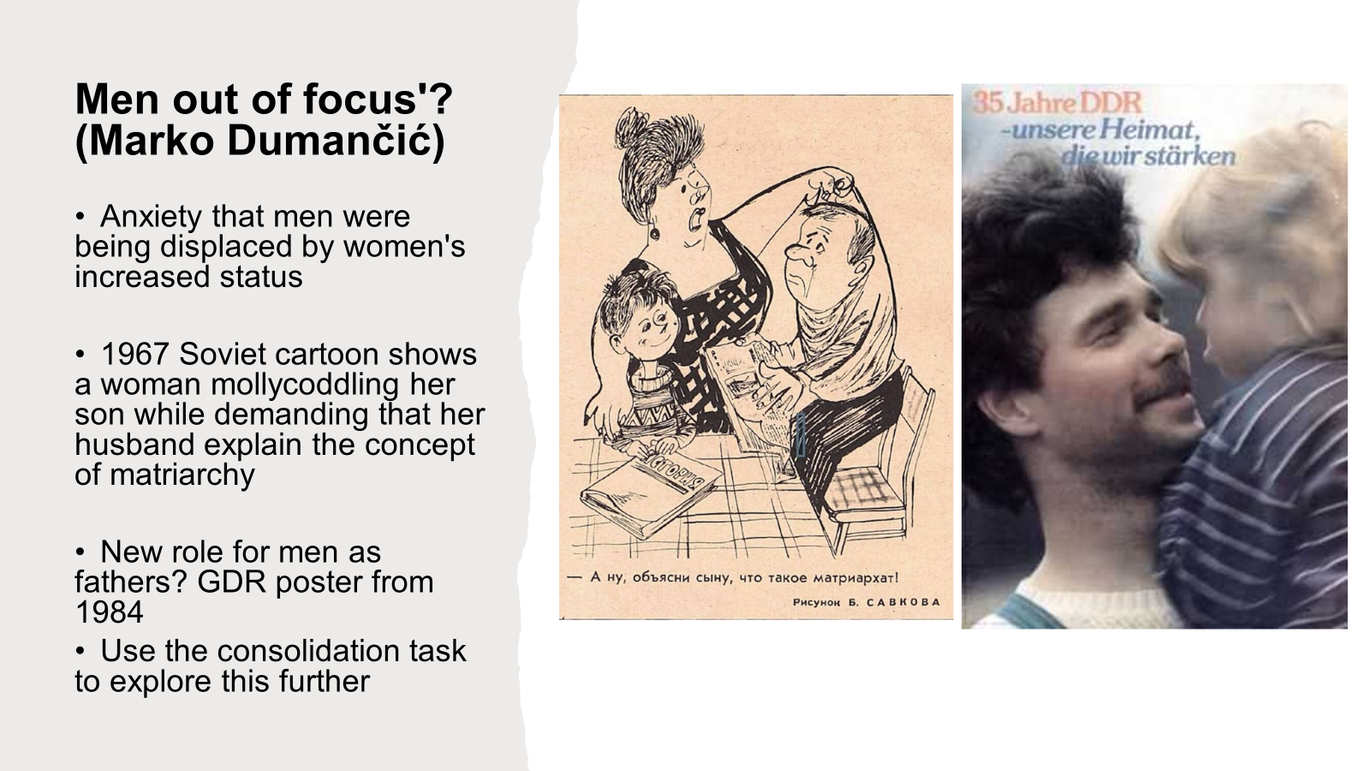
How effective were these posters?
Urban socialist 👪 merely → ↑ egalitarian & ↓ patriarchal.
Despite this, no communist state seriously chall. gendered culture 🏠.
Publicists’ action too little too late & still trivialised 🏠work.
Anecdotal evidence sugg. spouses jointly dec. important 👪 matters.
BUT division domestic lab. remained.
Eastern European & Soviet surveys 1970s (when alm. ½ workforce ♀): 👩 performed 80-90% 🏠hold work.
Shouldered alm. all 🧒-rearing tasks (feeding, nappy-changing, comforting, 🏠work-help…).
Though 🤵s & 🧒 helped w/🏠work, lower share
political: 👩 attain direct political power in any communist state
stats & organisations
why women underrepresented?
stats & organisations
Initially, no. women elected to nat. legislators [FS1] looked impressive, @ least relative to women’s low representation in West.
(most communist 👾s) 👩’s partic. peaked 1960s: 20-30%
Govt administration
👩’s partic. in communist party low @ bottom; alm. non-existent @ regional/ nat. level.
(even 1980s) Polish men comprised 75% (E. German 65%) their respective communist parties
👩 less likely to hold paid posts & v/
likelyto occupy pos. power, espec. above local levelParty central committees dominated by 👨 (includ. candidates & vot. members…)
(Czechslovakia (CSSR), 1980s) low of 7%
(Cuba, 1991) high of 17%
Politburu utterly ♂ preserve
Only 1 👩 ever vot. member Soviet politburu
(GDR Politburu) No 👩 attained vot. status).
Organisations (tamed)
see photo
Dur. CR, all Women’s Federation was forced to suspend itself, an indicator that women’s affairs were placed in a secondary position compared with what the Chinese Party considered as the more pressing political agenda during those years.
Why 👩 underrepresented?
∵ 2nd shift domestic lab. → employed 👩 had ↓ hrs than 👨 to engage in political activities, m/less to groom political career
![<h4 collapsed="false" seolevelmigrated="true">stats & organisations</h4><p>Initially, no. women elected to nat. legislators <a target="_blank" rel="noopener noreferrer nofollow" class="msocomanchor" href="#_msocom_1">[FS1]</a> looked impressive, @ least <span style="color: red">relative to women’s low representation in West</span>.</p><ul><li><p>(most communist <span data-name="alien_monster" data-type="emoji">👾</span>s) <span data-name="woman" data-type="emoji">👩</span>’s partic. peaked 1960s: 20-30%</p></li></ul><h5 collapsed="true" seolevelmigrated="true">Govt administration</h5><h5 collapsed="true" seolevelmigrated="true"><span data-name="woman" data-type="emoji">👩</span>’s partic. in communist party low @ bottom; alm. non-existent @ regional/ nat. level.</h5><ul><li><p>(even 1980s) Polish men comprised 75% (E. German 65%) their respective communist parties</p></li><li><p><span data-name="woman" data-type="emoji">👩</span> less likely to hold paid posts & v/<s>likely</s> to occupy pos. power, espec. above local level</p></li><li><p>Party central committees dominated by <span data-name="man" data-type="emoji">👨</span> (includ. candidates & vot. members…)</p><ul><li><p>(Czechslovakia (CSSR), 1980s) low of 7%</p><p>(Cuba, 1991) high of 17%</p></li></ul></li><li><p>Politburu utterly <span data-name="male" data-type="emoji">♂</span> preserve</p><ul><li><p>Only 1 <span data-name="woman" data-type="emoji">👩</span> ever vot. member Soviet politburu</p></li><li><p>(GDR Politburu) No <span data-name="woman" data-type="emoji">👩</span> attained vot. status).</p></li></ul></li></ul><h5 collapsed="true" seolevelmigrated="true">Organisations (<span style="color: red">tamed</span>)</h5><p><em>see photo</em></p><p>Dur. CR, all Women’s Federation was forced to suspend itself, an indicator that women’s affairs were placed in a secondary position compared with what the Chinese Party considered as the more pressing political agenda during those years.</p><h4 collapsed="false" seolevelmigrated="true">Why <span data-name="woman" data-type="emoji">👩</span> underrepresented?</h4><p>∵ 2nd shift domestic lab. → employed <span data-name="woman" data-type="emoji">👩</span> had ↓ hrs than <span data-name="man" data-type="emoji">👨</span> to engage in political activities, m/less to groom political career</p>](https://knowt-user-attachments.s3.amazonaws.com/50f6495e-9a83-4d61-9cc0-861f529da51b.png)
come to this after
(Donna Harsch) Why did communism fail to achieve gender equality?
Strength inherited gender norms, espec. in the domestic sphere.
big mountain to climb (patterns behaviour, partic. true when came to divisions lab. in domestic sphere) v/strong & diffic. to change
Communist ideology underestimated importance of women’s work in the home & failed to transfer domestic work to them.
forgot domestic work not going to dissapear when women worked outside home → not transferred to men → remained women’s men
Communism put industrial developm. 1st, & instrumentalised women’s paid & unpaid lab.
need to grow economies came above any other consid. → instrumenalising women’s paid (join workforce to grow econ.) & unpaid lab. (needed to stay in home because no plan for anyth. else + raise & rear children)
Communist states repressed civil soc. → no change for an equiv. women’s movem. to develop.
no change for women’s movem. to emerge in civil sphere (things didn’t like & wanted to change, put pressure on govt) because was 1-party dictarship → no pressure on stage to change things
(1945-) New communist states E.Europe & China controlled gender discourse ← above & prevented it ← veering off in radical directions.
Focus on class to exclusion other differences in soc.
Reliance on archetype of male proletarian.
‘While on the surface genderless, the ideal communist subject has distinctive masculine features, & women could never completely satisfy the requirements.’ Eva Fodor
Alth. communism said class most import. characteristic that 👩 could → ideal communist character, so based on power & devotion to work that 👩 were never going to complete mould & → full communsit citizen in the way a 👨 could
‘The persistent yet flexible nature of patriarchy’ (Eva Fodor)
patriarchy = powerful & adaptive system, diffic. to change
Women suffer inferior status compared with men in almost all spheres of life in the contemporary society. Stacey offers an explanation of the failure of the CCP to achieve gender equality in China. She argues that although the CCP brought to China dramatic changes in the areas and built new political, economic, social and cultural systems after the founding of the PRC, it is consistent with the dominant forces in China for thousands of years in the sense that it is patriarchal. “… the socialist revolution in China was a patriarchal revolution as well – a radical transformation in the rural patriarchal family mode of production. Confucian patriarchy was replaced first by new democratic patriarchy, and then by patriarchal socialism.” (Stacey, 1983, p. 253). For example, when land was redistributed to all the peasants during the land reform movement, it was distributed to men, instead of women. In other words, just like patriarchy and capitalism reinforce each in the capitalist society and perpetuate patriarchy, patriarchy and socialism have also transformed and structured each other in the process of establishing the current patriarchal social order in China.
come to this after
Did women attain equality under communism?
Under communism, women achieve equality w/👨.
Attain self-determination/social autonomy.Diffic. for communism to take gender as seriously as it needed to
Though tried to transform gender,
could get it right→ double burden & ↓ birth rate, which all capitalist soc. struggle w/tooOffer anyth. new in terms gender archetypes
Still, communism dramatically changed 👩’s social position.
In return, 👩 directly shaped communism’s trajectory.
Their decisions ab. educat., employm., ⚭ & reprod. (insert abortion?) forced communist parties to revise social programmes a& consumption policies.
Many 👩 came round to communism’s ideology ab. gender relations: importance waged work to 👩’s dep.
(1970s & 80s) Surveys: most 👩 USSR, GDR, & ČSSR felt committed to employm. (Poland) % just ↓ 1/2.
Educ. 👩 reported their work fulfilled them personally & seemed socially import. to them.
These results may sound revol. BUT ∵ attit. tow. 👩’s educ. & employm. transformed after early CW era. Communism contrib. signicantly to that transformation.
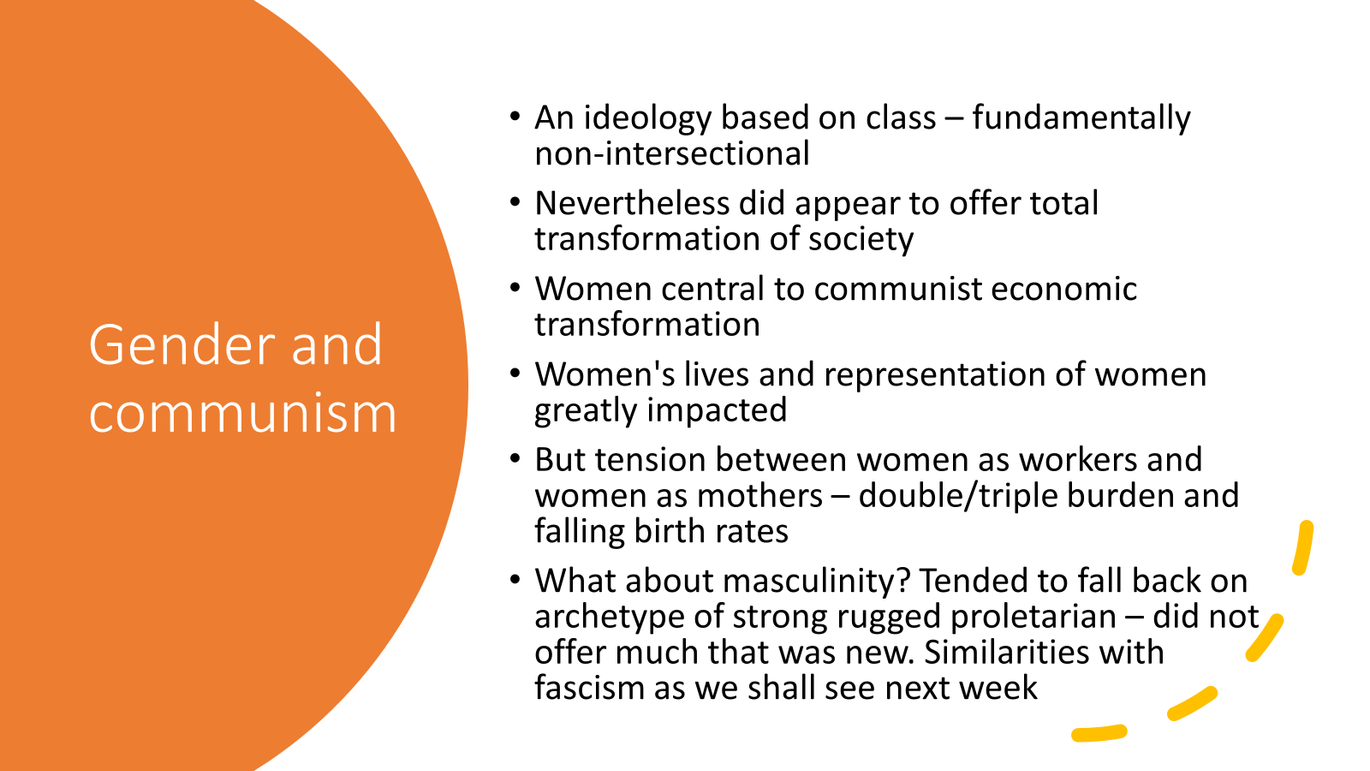
How China → communist
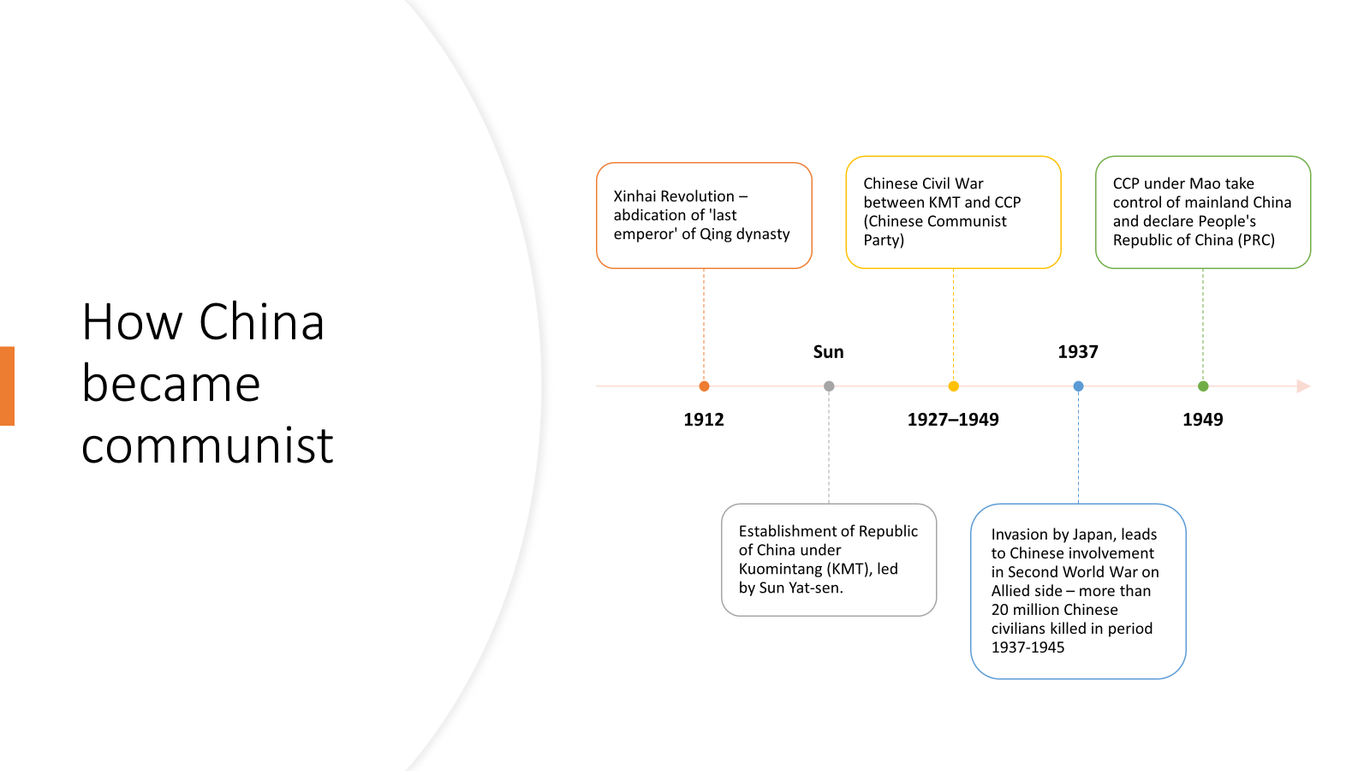
gender politics in early PRC
After 1949 revol., dramatic changes took place.
New govt People’s Republic made firm commitm. to guarantee equality bet. 👩 & 👨.
Famous quotation by Mao Zedong reflects the determination by the government to raise women’s status: “Women hold up half the sky.”
Need to stabilise soc. after decades war - attempt to strengthen 👪
Real feeling 👪 been damaged by war → campaign to ‘save’ 👪
☢ 👪 -
multigenerationalas would have been common in rural Chinese soc., w/🖼 Mao Ze Dong smiling over scene & blessing it like divine icon
Campaign to improve midwifery & 🧒 mortality
1950 ⚭ Law
Banned prostitution, arranged marriage, child betrothal & concubinage - 👓n as key part modernisation.
⚭ to be based on 💘 & mutual consent
👾 tak. control domain that had prev. been controlled by 👪 (just like USSR where taken out ⛪ control - should be indiv. dec. under 👾)
Communist regimes tend to be dictatorial - bring. everyth. under 👾 control.
(1950s) Why did Chinese 👾 promote ☢ 👪?
Part of broader strategy to…
These efforts were integral to the CCP's broader strategy of transforming Chinese society in line with communist principles.
Modernise soc. & enhance econ. productivity
Agricultural Reforms
Land reforms redistrib. 🟩 ← 🟩lords → indiv. peasant 👪s made _ small, ☢ 👪 ↑ econ. viable.
Each 👪 rec. its own plot 🟩, foster. sense of
dep.& reduc. need for extend. 👪 lab.
Urbanis.
Push tow. industrialis. req. mobile workforce.
☢ 👪s ↑ adaptable to needs urban liv., where housing typically limited & jobs & educ. often req. relocation.
_er 👪 units could move ↑ easily to cities to work in 🏭s & other urban enterprises.
Much recruitm. involved relocation many women ← rural areas to city.
Then in this other place they marry a person from a third place. Their children don’t grow up with their grandparents, and the grandparents live in two different places. Sometimes one of the couple has to move for a job, but the other cannot, so the family is separated. Sometimes the children can’t live with either parents, and must live with the grandparents.
Eroding Old Customs
Campaigns like "Four Olds" dur. Cultural Revolution sought to eradicate old customs, culture, habits, & ideas.
Promot. ☢ 👪 part this broader effort to create new socialist culture that aligned w/communist values & ideology.
Consolidate its control (political & ideologcal)
Break. Trad. Power Structures
Extended 👪s often centres trad. auth. & resistance to 👾 control.
By promot. ☢ 👪, 👾 weakened these trad. structures, mak. it easier to implement communist ideology & policies.
Work Units (Danwei)
👾 organ. urban workers into work units, which provided social services traditionally managed by extended families. This shift allowed the state to exert more direct control over individuals' lives, as people became more dependent on their work units for housing, healthcare, education, and other needs.
Gender equality & social reforms:
1950 ⚭ Law
to promote gender equality and dismantle feudal ⚭ practices.
By encourag. free-choice ⚭ & outlaw. practices like concubinage & 🧒 betrothal, 👾 fostered ↑ egalitarian relationships that aligned w/ ☢ 👪y model.
👩's partic. in workforce
👾 encourag. 👩 to join workforce, which necessitated shift aw. ← traditional extend. 👪model where 👩 primarily responsible for domestic duties.
This change supported the formation ☢ 👪s where both parents worked outside 🏠.
Social stability & econ. developm.:
Population control & improve liv. standards
☢ 👪 model part this broader efforts
_er 👪s 👓n as ↑ manageable & better able to contrib. to 👾’s goals econ. developm. & modernis.
Educational & social mobility
W/↓ 🧒, 👪s could invest ↑ resources in each 🧒's educat., which aligned w/👾's goal creat. skilled & educat. workforce.
How was this promoted in posters?
A new spacious home, a radio set, abundant and good food - cooked and served by mother - and three healthy children: the happy workers' family of the early 1950s.
Mao is super-present in ideal family life - for good of Mao
diff. because set in domestic sphere + only one w/such a direct ref. to Mao
this is what he approves of
looking at the viewer - watching them too
permeating private sphere & watching viewer directly, bigger than them
this is how you should act - threat
ironic that this is idealised family that must be promoted/ endorsed - clearly not reflecting cultural reality
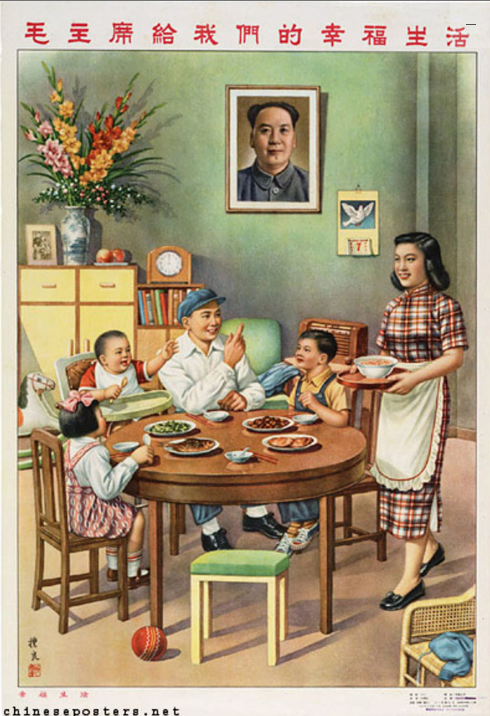
(Gail Hershatter) How were 👩 central to socialist modernisation?
👩’s lab. - both vis. &
vis.key to industrialise & bring agriculture under 👾 control
mobilis. 👩 to partic. in lab. force demanded by resturctur. econ. @ beg. stage PRC
New govt confronted w/heaby tasks rebuild. cities, develop. econ., (espec. industrial econ.) & est. or restor. social institutions & services.
👩 as symbol
Women made to stand w/everyth. wrong w/China & good ab. socialism & changes tak. place.
Somet. women decried as ignorant &
dep. drags on nat. econSomet. glorified as mothers who could save nation OR heroines who could hasten the achievem. of sociaism.
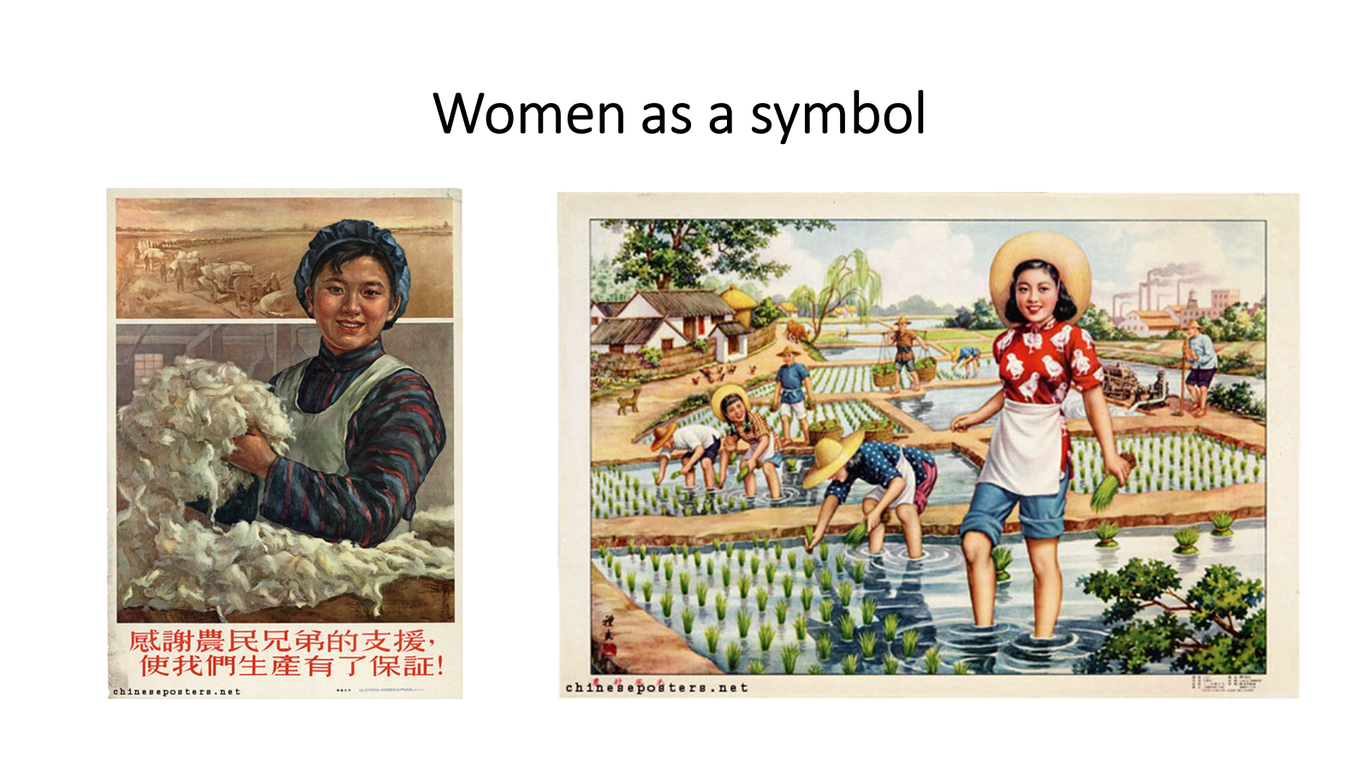
posters
Worker fulfilled & glowing w/happin. at her contrib. to socialism.
Some of these posters bore no relation to reality.
young, glamorous women dressed in modern fashionable clothes
bore v/little relation to any Chinese peasant woman working in rice paddy planting rice
symbolism for urban aud. & reality people’s lives
see seminar for more info
‘Iron Girls’
After agricultural collectivis. & start Great Leap Forw. Movem. (1958), China launched anoth. massive campaign to speed up econ. developm., espec. developm. industry & tech.
👩 strongly encouraged to go into lab. force, partic. industrial work (fields vacated by men who’d been transferred to ♂-orientated occupations).
Poster: idealised ‘Iron Girl’: strong, muscular, being cheered on by her colleagues for her achievements
That quote used lot
to say men & 👩 should have equal rights
expectations for men & 👩should be same - should carry the same load
These quotes deployed to argue women should be able to do same as men can → Iron Girls campaign intended to show women were…
not weak
no physical limitations
can go out and do anything, like these highly physical jobs in industry
1st quoted woman worked in oil field. Thinks of herself as damaged by physical work YET still feeling of romantic nostalgia
2nd woman’s exper. doesn’t reflect majority… most women had double/ triple/ quadruple burden…
Succ.
Although the Great Leap Forward Movement ended as a disastrous failure, it did bring women’s labor force participation to a nearly saturated level, and the pattern persisted throughout the Cultural Revolution period (1966-1976).
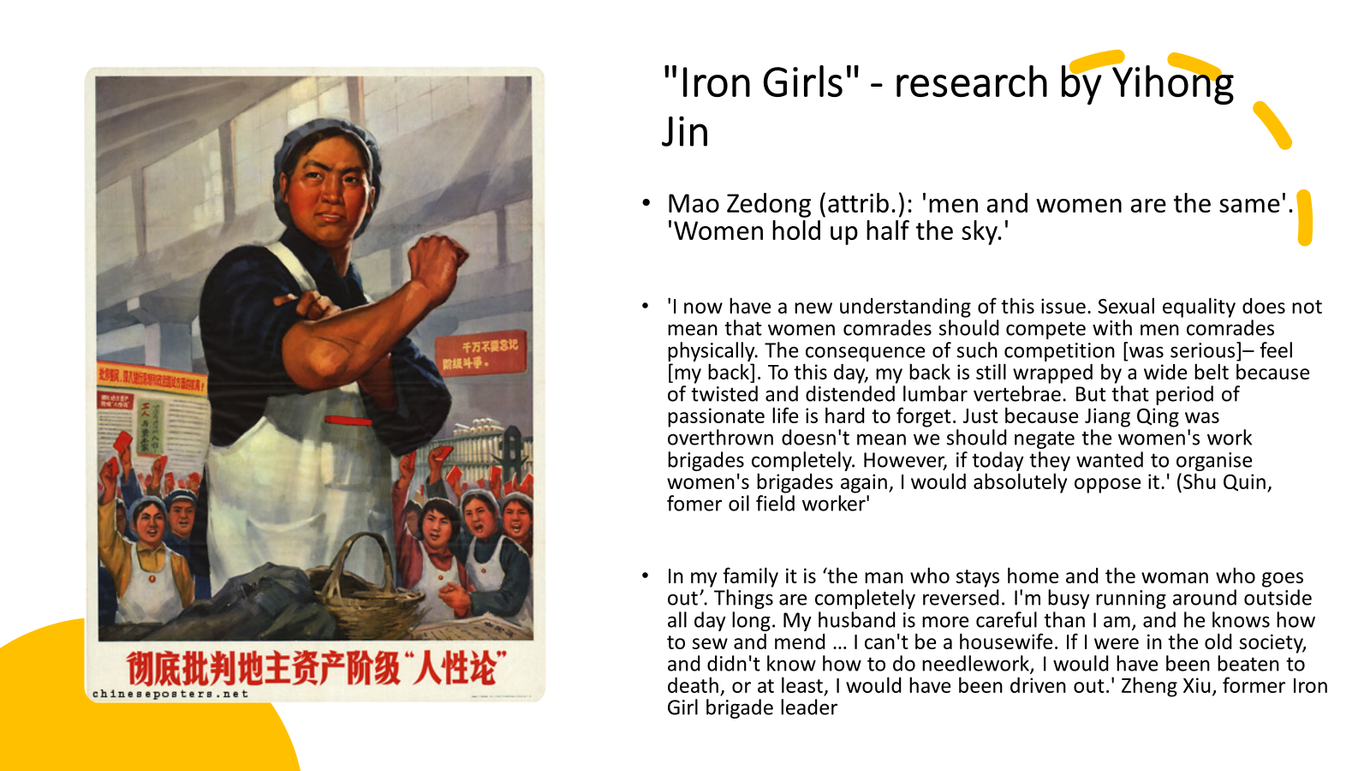
double/ triple/ quadruple burden
quote: ‘Iron Girls’ had no other responsibilities. Not seen w/baby under their arm → able to devote themselves fully to labour.
Mothers had other responsibilities to devote themselves to.

How did Cultural Revol. impact women?
What was it?
(1966-76) Campaign against the ‘Four Olds’ (ideas, customs, culture & habits’
top-down campaign
intensification class-conflict
Olds assoc. w/bourgeois lifestyles. China should → more assoc. w/WC values
→ Communist Party mobilises y/🧍 in form Red Brigades to seek out & destroy 4 Olds
partic. targeted @ y/MC
find & burn
acceptablethings→ countryside for many yrs work. in agriculture & construction as way to ‘re-educ.’ them
👩 sent to countryside expected to → just like 👨
‘the annihilation of femininity’? (Wenqi Yang & Fei Yan)
CR → ‘the annihilation of femininity’? (Wenqi Yang & Fei Yan)
Why?
‘The model for political behaviour in the early Cultural Revol. was an imagined version of the WC ♂’ Gail Hershatter
‘While on the surface genderless, the ideal communist subject has distinctive masculine features, & women could never completely satisfy the requirements.’ Eva Fodor writing on Hungary
Only prototypical-masculinis. 👩 permissible.
For purpose industrialisation + politics & so. considered expressions femininity as example bourgeois behavior and looked down on them.
Prevailing moralistic attitude aimed to repress anything that pertained to sexuality and the female body. Women were supposed to work, dress and look like men in clothing that was not supposed to reveal any female curves. With their sturdy features, robust faces and shining eyes, they denoted revolutionary commitment, youth, strength and determination
(Wang) Ignored women’s issues. Women hardly differentiated ← men/ simply rendered masc.
BECAUSE 🕑 when model for behaviour is young WC 👨. Used men as yardstick to eval. women. 👩 expected to just fit into it.
norms for men don’t change but women expected to be/ dress like men & do men’s jobs
women expected to do masculine means production
👩 wear. 👨’s clothes, doing 👨’s work… Uniform colur & unisex style pop. outfit
Slogans such as ‘Whatever men can do, women can do too’
Nothing tak. their physical form & biological sex into account

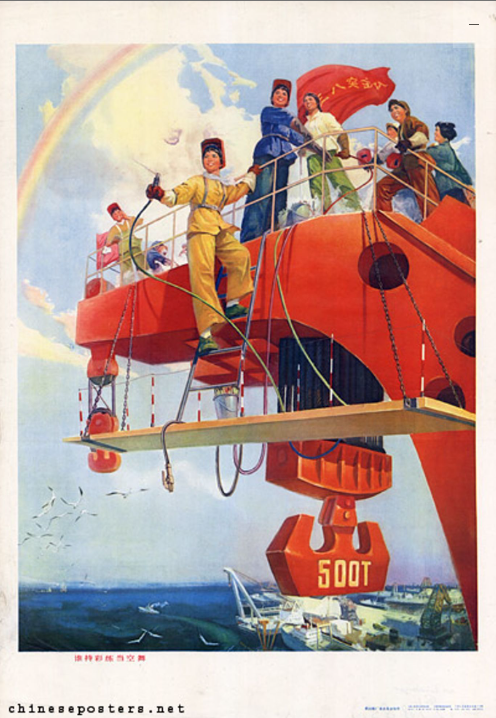
another Iron Girls poster show. masc. women
Those holding colored ribbons dance high in the sky
crane symbolises China? can work tog. to lift up the nation
dramatic scene idealises it - birds, rainbow, saturated colours…
bird symbolise freedom
gender-neutral: woemn could be swapped out for men
not recogn. women’s unique problems, over-simplifying the need for them to go into work whilst ignoring conditions that made it diffic. for them to do so
even women can reach up to the sky - show of the strnegth of the regime (like russia choosing female astronaut to show that)
deifies the women as role-models - we look up to them
use of plural - ‘we’ - communitarian → creating nat. cult-like community
1 🧒 Policy
China stands out as non-natalist communist 👾 promot. ‘👪 planning’ ← 1970s on.
Why?
Response to rapid pop. growth since 1949 due to rises in birth & decreases mortality rate. China victim its own succ.
Govt worry ab. pressures will put on hous., resources…
‘later, longer, fewer’
effective∵ standard living improving → choosing to have more children
How was this promoted/regulated?
promoted w/propaganda
magical looking city
scientific symbols in background repres. progress & modernity
assoc. small family w/modern family & nat. prog.
Workers must rec. 🏭’s permission to 🤰.
👪 planning officer lets them know when can have 🧒 (ask & be given permission… given birth permission card for when register 👶 @ 👮 station & for antenatal visits - if lose if they
get anoth.)on alert for anyone 🤰/ feeling broody (asking if on period…)
(1980s) forced abortions (e.g. @ 7 month)s & sterilisations
👪 planning officer ‘persuaded’ 👩 to have abortions
followed 👩 when ran away
all leaders commune came to persuade 👩
💪 coersion
What qualified you to have children?
must be over 24 yrs old
must rec. training family planning
must pass written test
must have policial/ intellectual capacity (eugenic element)
Urban-rural divide
Urban couples complied with its two-child, then one-child, policy. Rural couples often did not. Selective abortion became widespread and families under-reported female births. By the 1990s, 83 per cent of couples used contraception (mainly the intrauterine device and female sterilization).
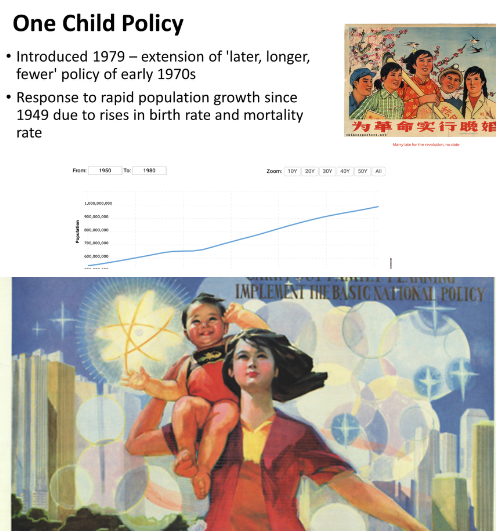
1 🧒 Policy
How did this alter culture?
Signif. this for gender
→ ↓ 👩
radically altered large family culture
parents depend on their children to look after them
women go to live with husband → parents encouraged to ignore rules & try again for son
strong application rules → abortions/ abandomnent (reports female infanticide) → unicorn generation (gender imbalance: more men than women) + opposite problem: too low pop. → encourag. women to have more children
Reflected fact women still suffered extrem. low status in Chinese culture
Focuses proportionately on 👩
policies based around reproductive policies women spec… women’s responsibility & control + being policed by women
women reduced to their biological function
reflects continued emphasis on women belonging in domestic realm
Shocking level interference in people’s private lives
e.g. have to get card to allow for child, sterilisation…
distrubing element viol. & coeresion (very late-term abortion & sterilisation)
woman traumatised in this way expected to sit & knit next to women who had significantly undermined her individualilsm
really strong example patriarchal soc. where strong control voer women’s reproductive decisions, & being implemented & enforced by women themselves
(Yuhui Li) gender politics China today
